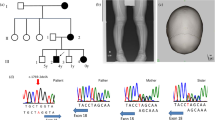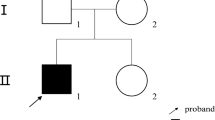Abstract
X-linked hypophosphatemic rickets (XLH) and m.3243A>G mitochondrial disease share several clinical findings, including short stature, hearing impairment (HI), nephropathy, and hypertension. Here, we report on a case with the rare coincidence of these two genetic conditions. In early childhood, the patient presented with hypophosphatemia and bone deformities and was clinically diagnosed with XLH. This was genetically verified in adulthood with the identification of a de novo pathogenic deletion in phosphate-regulating endopeptidase homolog X-linked (PHEX). In addition, the patient developed HI and hypertension and when his mother was diagnosed with m.3243A>G, subsequent genetic testing confirmed the patient to carry the same variant. Over the next two decades, the patient developed progressive renal impairment however without nephrocalcinosis known to associate with XLH which could indicate an m.3243A>G-related kidney disease. Parallel with the progression of renal impairment, the patient developed hyperphosphatemia and secondary hyperparathyroidism. In conclusion, this case represents a complex clinical phenotype with the reversal of hypo- to hyperphosphatemia in XLH potentially mediated by the development of an m.3243A>G-associated nephropathy.


Similar content being viewed by others
References
Beck-Nielsen SS, Brock-Jacobsen B, Gram J, Brixen K, Jensen TK (2009) Incidence and prevalence of nutritional and hereditary rickets in southern Denmark. Eur J Endocrinol 160(3):491–497
Rafaelsen S, Johansson S, Ræder H, Bjerknes R (2016) Hereditary hypophosphatemia in Norway: a retrospective population-based study of genotypes, phenotypes, and treatment complications. Eur J Endocrinol 174(2):125–136
Durmaz E, Zou M, Al-Rijjal RA, Baitei EY, Hammami S, Bircan I et al (2013) Novel and de novo PHEX mutations in patients with hypophosphatemic rickets. Bone 52(1):286–291
Carpenter TO, Insogna KL, Zhang JH, Ellis B, Nieman S, Simpson C et al (2010) Circulating levels of soluble klotho and FGF23 in X-linked hypophosphatemia: circadian variance, effects of treatment, and relationship to parathyroid status. J Clin Endocrinol Metab 95(11):E352–E357
Beck-Nielsen SS, Brusgaard K, Rasmussen LM, Brixen K, Brock-Jacobsen B, Poulsen MR et al (2010) Phenotype presentation of hypophosphatemic rickets in adults. Calcif Tissue Int 87(2):108–119
Manwaring N, Jones MM, Wang JJ, Rochtchina E, Howard C, Mitchell P et al (2007) Population prevalence of the MELAS A3243G mutation. Mitochondrion 7(3):230–233
Elliott HR, Samuels DC, Eden JA, Relton CL, Chinnery PF (2008) Pathogenic mitochondrial DNA mutations are common in the general population. Am J Hum Genet 83(2):254–260
de Laat P, Rodenburg RR, Roeleveld N, Koene S, Smeitink JA, Janssen MC (2020) Six-year prospective follow-up study in 151 carriers of the mitochondrial DNA 3243 A>G variant. J Med Genet 58(1):48–55
Chinnery PF, Howell N, Lightowlers RN, Turnbull DM (1997) Molecular pathology of MELAS and MERRF. The relationship between mutation load and clinical phenotypes. Brain 120(Pt 10):1713–1721
Francis F, Strom TM, Hennig S, Böddrich A, Lorenz B, Brandau O et al (1997) Genomic organization of the human PEX gene mutated in X-linked dominant hypophosphatemic rickets. Genome Res 7(6):573–585
Verge CF, Lam A, Simpson JM, Cowell CT, Howard NJ, Silink M (1991) Effects of therapy in X-linked hypophosphatemic rickets. N Engl J Med 325(26):1843–1848
Nakamura Y, Takagi M, Takeda R, Miyai K, Hasegawa Y (2017) Hypertension is a characteristic complication of X-linked hypophosphatemia. Endocr J 64(3):283–289
DeLacey S, Liu Z, Broyles A, El-Azab SA, Guandique CF, James BC et al (2019) Hyperparathyroidism and parathyroidectomy in X-linked hypophosphatemia patients. Bone 127:386–392
Guillausseau PJ, Massin P, Dubois-LaForgue D, Timsit J, Virally M, Gin H et al (2001) Maternally inherited diabetes and deafness: a multicenter study. Ann Intern Med 134(9 Pt 1):721–728
de Laat P, van Engelen N, Wetzels JF, Smeitink JAM, Janssen MCH (2019) Five non-mitochondrial myopathy, encephalopathy, lactic acidosis and stroke-like episodes phenotype adult patients with m.3243A>G mutation after kidney transplantation: follow-up and review of the literature. Clin Kidney J 12(6):840–846
Hall AM, Vilasi A, Garcia-Perez I, Lapsley M, Alston CL, Pitceathly RD et al (2015) The urinary proteome and metabonome differ from normal in adults with mitochondrial disease. Kidney Int 87(3):610–622
Fromont I, Nicoli F, Valéro R, Felician O, Lebail B, Lefur Y et al (2009) Brain anomalies in maternally inherited diabetes and deafness syndrome. J Neurol 256(10):1696–1704
Bowen J, Richards T, Maravilla K (1998) MR imaging and proton MR spectroscopy in A-to-G substitution at nucleotide position 3243 of leucine transfer RNA. AJNR Am J Neuroradiol 19(2):231–234
Ros I, Alvarez L, Guañabens N, Peris P, Monegal A, Vázquez I et al (2005) Hypophosphatemic osteomalacia: a report of five cases and evaluation of bone markers. J Bone Miner Metab 23(3):266–269
Hannah-Shmouni F, Sirrs S, Mezei MM, Waters PJ, Mattman A (2014) Increased prevalence of hypertension in young adults with high heteroplasmy levels of the MELAS m.3243A>G mutation. JIMD Rep 12:17–23
Fishman G, Miller-Hansen D, Jacobsen C, Singhal VK, Alon US (2004) Hearing impairment in familial X-linked hypophosphatemic rickets. Eur J Pediatr 163(10):622–623
Kaufmann P, Engelstad K, Wei Y, Kulikova R, Oskoui M, Sproule DM et al (2011) Natural history of MELAS associated with mitochondrial DNA m.3243A>G genotype. Neurology 77(22):1965–1971
Tinggaard J, Aksglaede L, Sørensen K, Mouritsen A, Wohlfahrt-Veje C, Hagen CP et al (2014) The 2014 Danish references from birth to 20 years for height, weight and body mass index. Acta Paediatr 103(2):214–224
Funding
No funding was received for conducting this study.
Author information
Authors and Affiliations
Contributions
Data collection and analysis were performed by SRN. The first draft of the manuscript was written by SRN and all authors commented on previous versions of the manuscript. All authors read and approved the final manuscript.
Corresponding author
Ethics declarations
Conflict of interest
Simone Rask Nielsen, Stinus Gadegaard Hansen, Claus Bistrup, Klaus Brusgaard and Anja Lisbeth Frederiksen have no relevant financial or non-financial interests to disclose.
Consent for Publication
The patient gave written informed consent for the publication of this article.
Additional information
Publisher's Note
Springer Nature remains neutral with regard to jurisdictional claims in published maps and institutional affiliations.
Rights and permissions
Springer Nature or its licensor holds exclusive rights to this article under a publishing agreement with the author(s) or other rightsholder(s); author self-archiving of the accepted manuscript version of this article is solely governed by the terms of such publishing agreement and applicable law.
About this article
Cite this article
Nielsen, S.R., Hansen, S.G., Bistrup, C. et al. Bone Deformities and Kidney Failure: Coincidence of PHEX-Related Hypophosphatemic Rickets and m.3243A>G Mitochondrial Disease. Calcif Tissue Int 111, 641–645 (2022). https://doi.org/10.1007/s00223-022-01010-x
Received:
Accepted:
Published:
Issue Date:
DOI: https://doi.org/10.1007/s00223-022-01010-x




